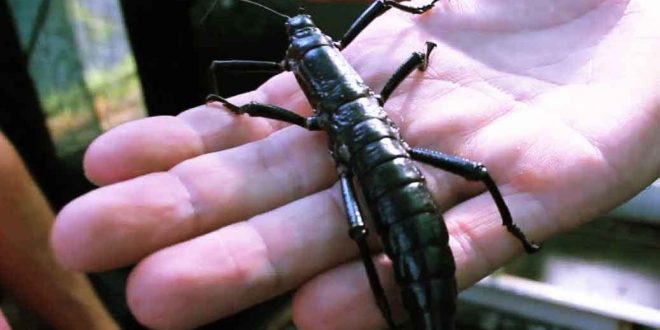Scientists identify the Lord Howe Island stick insect on the remains of a large volcano in the Tasman Sea between Australia and New Zealand.
In the 1960s, rock climbers on Ball’s Pyramid, a small, isolated volcanic stack located in the Tasman Sea, discovered a treasure that would mark the beginning of an incredible story of survival. The treasure was the freshly dead remains of what seemed to be Lord Howe Island stick insects—creatures thought to have gone extinct about three decades prior. They disappeared from their home on nearby Lord Howe Island after a shipwreck in 1918 introduced black rats into the island’s ecosystem. As the island had no native terrestrial mammals, the rats wiped out the stick insect population along with 5 bird species and 12 other insect species. Following the climbers’ discovery, a 2001 survey of Ball’s Pyramid revealed a few live individuals feeding on a single tea-tree atop a terrace 65 meters above sea level. One year later, another survey discovered a total of 24 insects, all living among a collection of tea-trees on the very same terrace as the year before. The survey expedition members then collected some of these individuals for further study and began a captive-breeding program at the Melbourne Zoo.
However, there remained some doubt over whether the Ball’s Pyramid stick insects were the same as the thought-to-be-extinct Lord Howe insects—for one, they looked somewhat different from the museum specimens collected from Lord Howe Island. Dispelling this doubt was important, because the answer could make or break an effort to reintroduce them back into their native home on Lord Howe Island.
Now, researchers at the Okinawa Institute of Science and Technology Graduate University (OIST), in collaboration with Zoos Victoria and the Australian National Insect Collection (CSIRO), have used next generation sequencing to confirm that the Ball’s Pyramid insects are indeed the same species as Lord Howe Island’s. And thus, the long-lost stick insect has been officially resurrected, contributing to the conservation efforts that are underway. The paper will be published in the journal Current Biology.
For the study, the OIST researchers assembled mitochondrial genomes from both captive-bred Ball’s Pyramid island stick insects as well as preserved specimens of Lord Howe Island stick insects from CSIRO’s Australian National Insect Collection, that were collected before the species was declared extinct. The researchers then compared the genomes and discovered that despite the observable differences between the two insects, their DNA diverged by less than 1%. This percentage is within the range of intraspecific variation, meaning that they are similar enough to be declared the same species.
“In this case, it seems like we’re lucky and we have not lost this species forever, although by all rights we should have,” says Professor Alexander Mikheyev from the Ecology and Evolution Unit at OIST and lead author on the research paper. “We get another chance—but very often we do not.”
There is now strong government and community support for eradicating the black rats from Lord Howe Island, which would provide the opportunity to reintroduce the insect into its native home. The genetic data gathered by the research study will also be useful for tracking the health and expansion of any reintroduced populations.
Professor Mikheyev points out that the research study’s success is important for more than just the stick insect’s continued survival. For example, it demonstrates how, with next generation sequencing technology, museum specimens have become gold mines of genetic data. Whereas in the past researchers could do little more with specimens other than observing them, or risking damage them with more in-depth studies, they can now sequence entire genomes of long-lost species.
In addition, embedded within the research and the Lord Howe Island stick insect’s story is a larger message related to conservation. “The stick insect [story] illustrates the fragility of island ecosystems, and in particular, how vulnerable they are to manmade change like invasive species,” Professor Mikheyev says. “It just took one shipwreck, and the fauna of the island has been altered in such a fundamental way.”
Agencies/Canadajournal
 Canada Journal – News of the World Articles and videos to bring you the biggest Canadian news stories from across the country every day
Canada Journal – News of the World Articles and videos to bring you the biggest Canadian news stories from across the country every day



